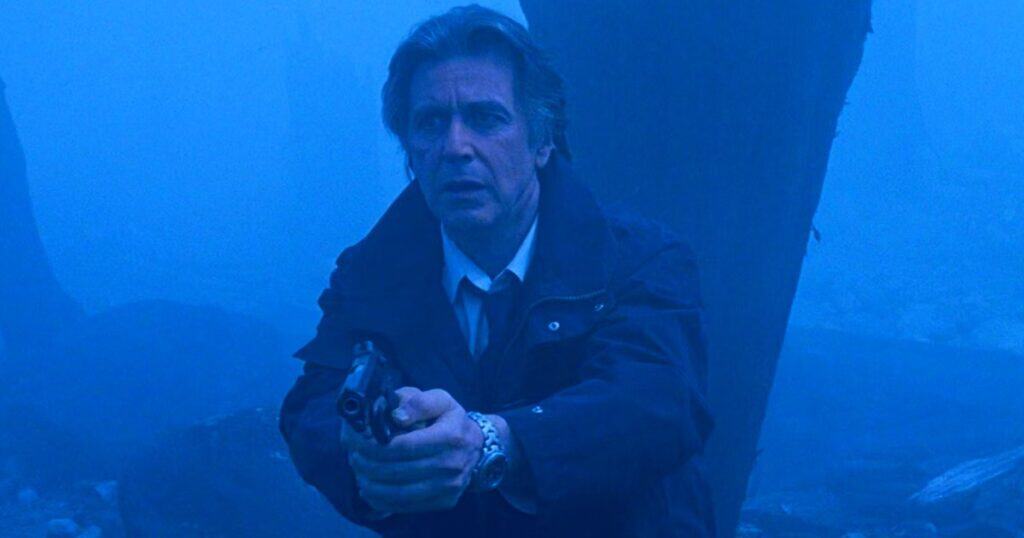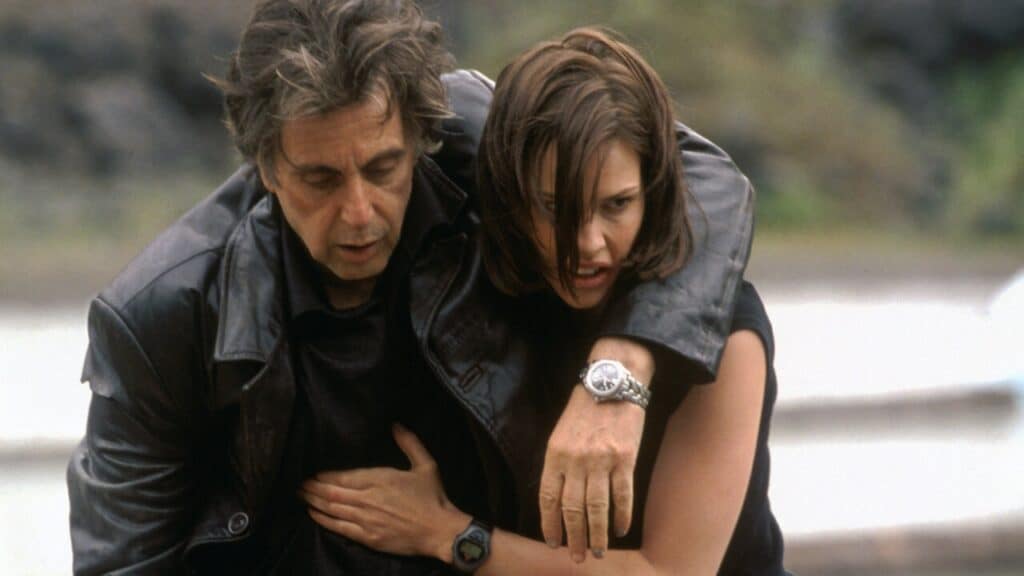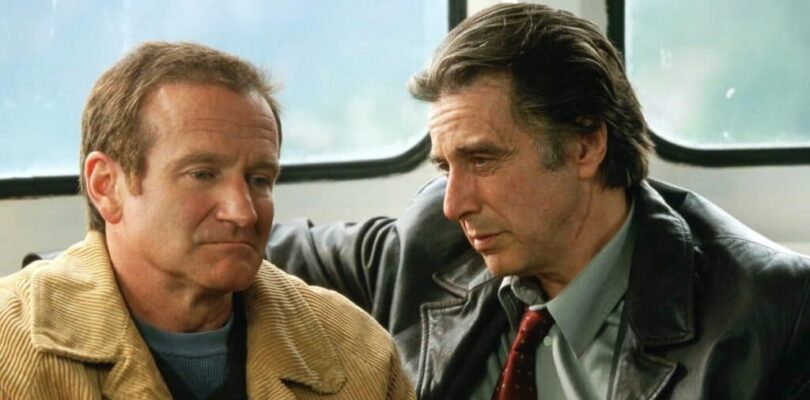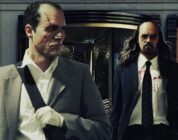The episode of WTF Happened to This Horror Movie? covering Insomnia was Written and Narrated by Mike Holtz, Edited by Jaime Vasquez, Produced by Andrew Hatfield and John Fallon, and Executive Produced by Berge Garabedian.
In 2002, Christopher Nolan directed a film set in a small town in Alaska where the sun doesn’t go down for days at a time. The film starred the great Al Pacino as a once again decorated but tortured Detective at full Heat level intensity, squaring off against the legendary Robin Williams in an against-type role as a creepy, cerebral murderer of a teenage girl. And somehow……some way…..it’s considered underrated. Christopher Nolan. Al Pacino. Robin Williams. Underrated. These are not words that go together. So, let’s talk about just WTF Happened to Insomnia.
These days, in the year of our dark lord 2024, Christopher Nolan is an undeniable titan in Hollywood. After films like his Batman trilogy, Interstellar, and his most recent film Oppenheimer, he’s as much of a household name as a director can be. He’s won everything there is to win. The guy could direct a movie about a toasted cheddar chalupa and just the sound of the words leaving his lips with his smooth accent would make it sound regal and grandiose: “Toasted Cheddah Chalupa” and you just know it’s going to be huge. As it should be. They are delicious. So, when I tell you this next bit, it’s going to sound strange. When Christopher Nolan heard Warner Brothers was trying to remake a 1997 Norwegian thriller directed by Erik Skjodbjaerg and starring Stellan Skarsgard called Insomnia, his agent couldn’t even get him a meeting with the studio. Baffling, considering the same studio executives would probably do a cannonball into the needle pit from Saw II just to get Nolan to eat a bagel with them in 2024. But again… they hadn’t even seen Memento yet at this period in time. Which is the movie that would change everything for Nolan. But not without a little help. According to the book The Nolan Variations by Tom Shone, established Hollywood director, producer, and experimental filmmaker Steven Soderbergh was the catalyst that made all this happen. After screening Memento for himself and hearing of Nolan’s inability to get in a room with Warner Bros, Soderbergh allegedly stormed across the lot of Warner Bros and told the head of the studio at the time, whoever it was, (I’m picturing Satan personally, you go with whatever you like) and said, “you’re insane if you don’t meet with this guy” and eventually offered to Executive Produce the film himself, along with George Clooney, were they to give Nolan a chance. In Christopher Nolan’s own words, “Steven Soderbergh basically got Insomnia made”.
What was it that made Nolan so interested in remaking a film like Insomnia so early in his directing career? Nolan had stumbled across the film while working on the unreleased at-the-time Memento and was so enamored he watched it twice in one sitting. Of the experience, Nolan said, “I’d love to do this in a slightly different way. If you take that situation you can make it into a Hollywood movie with big movie stars. You could make it like Heat.”
At the time when Warner Bros finally decided to give Nolan a chance to direct the film, they had already given the script writing duties to an extremely new to the scene Hillary Seitz. Because of this and the lack of official writing credit on the film, many cite Insomnia as the only film of his that Christopher Nolan didn’t write. This is factually correct if IMDB is watching but it isn’t the full story.
The truth is, Nolan did his own rewrites of the script in 2000. Of this situation, Nolan said, “I don’t have a writing credit on the film and I didn’t ask for one. Because when I came on as director, Hillary Seitz really rewrote the script in the ways that I wanted her to, but I did do a set of rewrites for Pacino that were reasonably substantial.” So, take from that what you will. I definitely consider Nolan a writer on this one.
In the film, we follow Pacino’s character, LA Detective Will Dormer (whose name actually means “sleep” in multiple languages) as he’s being investigated by Internal Affairs for allegedly going too far to have his criminals put behind bars. He’s sent to the small town and Halibut fishing capital of the world, called Nightmute, Alaska to get away from it all and help solve the case of a murdered teenage girl. The kicker here is that the town is currently in one of its phases of the year where the sun doesn’t go down. Like, at all. For days. Now, if you’re like me and you’ve had your brain go coo-coo for Cocoa Puffs after working the night shift for an extended amount of time, you can already feel this situation taking hold. It’s not good for someone like Dormer who’s already stressed and exhausted and whose partner just informed him he’s going to cut a deal with internal affairs to cover his own ass, possibly putting child murderers Dormer put away back on the streets and ruining his life’s work. To make it worse, this jerk (played perfectly by actor Martin Donovan, who would later work with Nolan again on Tenet) just casually tells him all this as if it’s no big deal, then tries to use the waitress as a human shield of awkwardness to which Dormer gives him this amazing stare.
Eventually, in one of those unforgettable movie scenes, that just make films such as the diner scene in Heat or the pool sequence from The Strangers Prey at Night, Dormer is giving chase to the killer in an intense fog when he fires his weapon and realizes he’s mistakenly shot and killed his partner Hap instead. Hap thinks that Will has done this on purpose and screams “Get away from me!” in his last moments as Will tries to help him and the killer watches from the fog. Will has to lie and say that the killer was the one who shot his partner, knowing that no one would believe him once it gets out his partner was about to cut a deal with Internal Affairs. What follows is a cat-and-mouse game with Dormer and everyone else, including the killer who’s blackmailing him to frame someone else for the crime, as he struggles with the weight of his guilt and decisions. While also going seven straight days and nights unable to sleep. And for those of you wondering, that’s really f*cking hard to do. No human being on record has ever gone more than eleven days straight without sleeping and lived to tell the tale.
Though the film was a remake, it was the rare version of a remake that changed enough to have its own identity, even pleasing the director of the original film who said, “It was quite close, stylistically, to the original. I felt lucky that it’s such a well-crafted, smart film and that it had a really good director handling it, because as a remake I think it did really well, and it doesn’t hurt any original if a remake is well done.” Nolan’s Insomnia not only honored the film it was remaking but was also clearly inspired by the others who had come before. There’s a Hitchcockian feel to the movie that Nolan himself mentions several times as well as multiple similarities to Johnathan Demme’s Silence of the Lambs. Ironic, considering Demme was at one point attached to direct the film himself. But Nolan had the job and the rest was history. He would use his cast to make one of the biggest changes between the original and his own, stating “The original film is very brilliant in its process of slow alienation from the protagonist. My film’s the opposite. You go with him on the journey and in a way you get closer to him at the end than you are at the beginning. I love the idea of going okay, take this exact plot but you just change a few things. You change your relationship with them. That’s the point of stars. They have a relationship with the audience. You tend to trust them.” The studio, though still wary of Nolan agreed with him on this point. Which led to the hire of maybe the biggest star of all… Al Pacino.

Pacino was coming off a ten-year stretch that included some of his most fun and intense roles. Movies like Heat as mentioned earlier, The Devil’s Advocate, Any Given Sunday, and Carlito’s Way. He brought that same intensity to the set of Insomnia. With limited time to rehearse, Nolan and Pacino worked hand in hand in either reigning in that intensity or letting it off the leash. Nolan said that Pacino would request to do multiple takes with varying levels of intensity during his scenes but that Pacino was one of the greatest actors to ever live and he very easily could have simply used the first take each time.
On the opposite side of the spectrum was the late Robin Williams, one of the funniest people on planet Earth, taking a turn for the dark side for the second time in 2002 (as the film One Hour Photo released the same year) in the role of an author turned teen murderer, Walter Finch. Though Nolan noted that Williams was a delight on set, there was a method to Williams’ madness as well. Williams said that he had watched an interview of serial killer Jeffrey Dahmer where Dahmer calmly explained to a TV crew how he would store the bodies of his victims and how it freaked them all out. He said “The creepier, the more normal and regular it seems… the creepier it is because that’s the way it is. To play it just straight and regular and much like this because people like that feel like they are not entitled, but it’s how they function.” In the end, Williams would deliver an amazing subdued, and complex villain that is hard to shake….even as you see his body disappear into the cold Alaskan water after being shot by Dormer at the end of Insomnia. He disappears into the nothingness as if he were never there… which was exactly the intent. Nolan would later say of the character, “In my conversations with Robin, I did actually say to him ‘This is something we’ll only talk about, but the guy could be unreal… as in he might not exist. He’s very much Dormer’s conscience”.
An interesting idea that would give you a great excuse to watch Insomnia again, although that isn’t the reality they decided to go with. It’s fascinating to consider. But as Lucas from Empire Records once said, “Always play with their minds.” Nolan would go on to praise William’s work in Insomnia further, saying, “I wound up watching the film hundreds of times as we cut it, and I never hit that point with the performance where you start to see the acting. Most performances, at a point, bits start to peel off and away…but with Robin’s, he was very much in that character. Not that he’s a very dark person to work with- he’s very lively and friendly and amusing to work with. He really found something within himself. I think it’s a very underrated bit of work on his part.”
Hillary Swank was cast as Detective Ellie Burr, who idolized Dormer’s work and was eager to get her chance to affect the world in the same way. Her character in the end would use all she learned from Dormer to realize that he was indeed the one to shoot his partner and the final conduit for Dormer to finally receive a cathartic release for his guilt, telling her not to “lose her way” by throwing out the evidence, though she knew it was an accident. And though it was the last moment of his life, he was finally able to get some sleep, his soul finally unburdened.
It was this guilt that was the main theme of Insomnia and the reason that if you wanted to you could watch the film under the spell that its killer was simply a figment of Dormer’s imagination. Watching such a talented actor as Pacino in his bag of goods, playing a character being broken to the very core by his guilt and lack of sleep is something to behold and by all accounts the main story at play here. Nolan himself said, “To me, the film is about responses to guilt and you’ve got two characters who deal with guilt in opposite ways. In fact, that’s what makes the relationship between them quite interesting.” On the lack of sleep front, Soderbergh was quoted as saying that was the most difficult task in making the film, saying, “The biggest challenge in a movie like this is creating the impression of fatigue and what it means to be tired without making the audience tired. You have to come up with some interesting visual ways to suggest that state of mind without lulling people into some stupor” Which, Insomnia did in spades using fragmented editing, up close camera shots, and the acting talents of Al Pacino. Yeah, I know, I know. You get it. I love Al Pacino.

The sunlight and setting played as important a role as Pacino, Williams, or Swank. The sun becomes an unrelenting metaphor for Dormer’s guilt and his inability to escape his current situation. The setting of Alaska (though mostly filmed in British Columbia), framed beautifully by Christopher Nolan’s right-hand man Wally Pfister, provides the ambiance for multiple memorable moments. From the plane ride at the beginning of the movie to a chase scene that ends with Dormer trapped in the water under a series of logs smashing together violently, to the famous and aforementioned fog scene. Pfister and Nolan also used the sun to their advantage in terms of cinematography with Nolan noting “We wanted to make a very dark film that had ever-present light.” Amidst all the beautiful settings, cinematography, metaphors, and intrigue…we were still treated to one-of-a-kind moments and one-liners like this one between Pacino and Williams: “You’re about as mysterious to me as a blocked toilet is to a plumber.”
So, Nolan had his cast, his cinematographer, his locations, and the wind at his back. But he still didn’t have the full trust of the studio. Who put him through multiple test screenings and even made him film an ending where Pacino’s character lived. Nolan explained “Probably the trickiest thing with Insomnia was we had to shoot two endings. I changed the (original) ending actually at Steven’s suggestion. He said to me, ‘He should die at the end and then it is like a John Ford film’. And I thought ‘yeah, that makes a lot of sense’. The whole thing becomes much more about the man’s interior and ethical journey. The studio was not happy about this. And so, they made me promise to shoot it both ways. And I did shoot it both ways. Pacino was not happy about it. But basically, I said to him ‘Look, I gave them my word I would do it’…and he respected that.”
Warner Bros never even as much as asked to see the other ending and Nolan never even edited it together. But the test screeners were still a pest for Nolan who said, “First Alcon, then Warner Bros made us test it. I haven’t done it since, but that is where they literally write you a book of how to fix your films, and it’s a brutal process. We had to do it three or four times over many months and it was a very, very stressful process of being almost pitted against the audience in a way, which is not what filmmaking is.”
Regardless, the film would be released on May 24th, 2002 to the tune of 114 million worldwide (on a 46 million dollar budget). The reviews were overall outstanding, the director of the original was pleased, and all was right with the world. Nolan specifically calls it his most underrated film, saying “I’m very proud of the film. I think, of all my films, it’s probably the most underrated….That’s not really for me to say, but every now and again I meet a filmmaker and that’s actually the film that they’re interested in or want to talk about.” He also goes on to say that the film was one of the best-reviewed of his entire career at the time, which “helped a lot”. Which, it clearly did considering Warner Bros. trusted him enough to hand him the keys to the Batman universe afterwards…..and we all know how that turned out.
As far as why Insomnia feels underrated when you look at Nolan’s filmography? It’s hard to say. Nolan thinks it may be because it wasn’t genre-changing enough, saying, “Of all the films I’ve made, it sits the most squarely or comfortably within the genre that I was trying to make it in. It doesn’t really change the genre, and that’s what people have come to expect from the other films I’ve made. But I think the film holds up very well.” And I would agree. Insomnia is one of those movies that you kind of forget exists for whatever reason but then get really excited to watch it when it creeps through the fog and back into your brain again. And that, my friends, is just WTF happened to Insomnia. Thanks for watching and remember to catch Christopher Nolan’s Toasted Cheddar Chalupa, in theaters this Summer.
A couple of the previous episodes of WTF Happened to This Horror Movie? can be seen below. To see more, head over to our JoBlo Horror Originals YouTube channel – and subscribe while you’re there!




